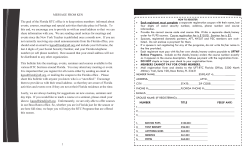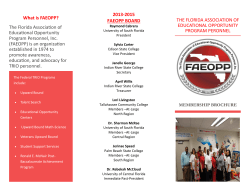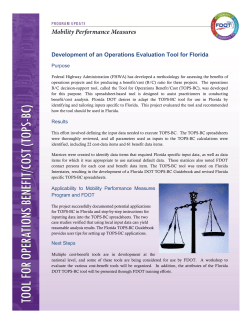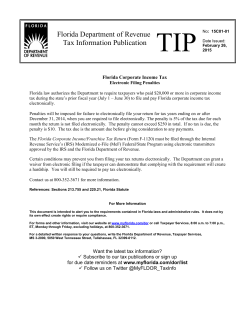
PRESS RELEASE
PRESS RELEASE Media Contact: Heidi Morgan, Director Center for Internet Augmented Research and Assessment (CIARA) Florida International University 305-348-2006 heidi@fiu.edu AtlanticWave-SDX: A Distributed Intercontinental Experimental Defined Exchange for Research & Education Networking Software Miami, Florida, April 15, 2015 – Florida International University’s Center for Internet Augmented Research and Assessment (CIARA) is pleased to announce AtlanticWave-Software Defined Exchange: A Distributed Intercontinental Experimental Software Defined Exchange (SDX) NSF Award ACI#1451024. Software Defined Networking (SDN) deployments that cross multiple domains are constructed manually, involving significant coordination and effort by network operators. Americas Lightpaths (AmLight) is a production infrastructure for communication and collaboration between the U.S. and Western Hemisphere science and engineering research and education communities. In August 2014, AmLight evolved to become a full SDN. Demand is growing to develop the capability to support end-to-end network services, capable of spanning multiple SDN domains. Capabilities and resources to operate multi-domain/multi-layer SDN networks must evolve in order for the delivery of end-to-end services to scale. In response Florida International University (FIU) and Georgia Institute of Technology (GT) are collaborating on the AtlanticWave-SDX: a distributed experimental SDX, supporting research, experimental deployments, prototyping and interoperability testing, on national and international scales. In addition, AtlanticWave-SDX aims to take on a leadership role in the planning, coordination and prototyping of experimental SDX by creating an environment in which researchers and practitioners can collaborate on at-scale experimentation and prototyping of SDN applications and services, enabling domain scientists to instantiate instruments on demand, or application-specific infrastructure on demand, across multi-domain networks, on a global scale. AMPATH, led by FIU and SoX, led by GT, are Open R&E Exchange Points (RXP), operating as Platforms of Network Innovation. Both serve U.S. science research and education communities by managing productionlevel operational open exchange points, connecting a diverse community of national and international R&E networks. Both also support and participate in experimental Openflow/SDN deployments. AtlanticWave-SDX is comprised of two components: (1) a network infrastructure development component to bridge 100G of network capacity between R&E backbone networks in the U.S. and South America; and (2) an innovation component to build a distributed intercontinental experimental SDX between the U.S. and South America, by leveraging open exchange point resources at SoX (Atlanta), AMPATH (Miami), and Southern Light (São Paulo, Brazil). Florida LambdaRail (FLR), Florida’s Research and Education Network, supports FIU/AMPATH in this partnership in Florida. For the past 12 months FLR, in collaboration with FIU/AMPATH, has been conducting SDN experimentation to provide a 100G wave in support of the NSF AmLight OpenWave experiment between Miami and Jacksonville. By June of this year, FLR will have completed a 100 Gbps upgrade of its entire 1,540 miles network. “A key driver for us in support of our 100G network upgrade is our commitment to enabling statewide, regional, national and international research initiatives,” said Joseph Lazor, CEO of Florida LambdaRail. “We are excited about AtlanticWave-SDX as it presents a great opportunity for our global research & education community to take advantage of our new capacity to collaborate on vital nextgeneration network research and application development.” 1 The absence of operational multi-domain SDN networks limits the usability of SDN to motivate the development of novel services and applications. A distributed experimental SDX will provide an environment for development and prototyping of functions and services essential towards advancing knowledge to support end-to-end services, capable of spanning multiple SDN domains. Caltech working together with iCAIR, Internet2 and ESnet intends to extend this functionality to sites involved in the LHC program across the US and in Europe as well as Latin America through AtlanticWaveSDX. Harvey Newman, Professor of Physics at Caltech, said: "Software-driven strategic load balancing and flow moderation across a global set of SDXs are an essential part of the emerging picture of the next generation of intelligent networks. This will help physicists throughout the world to realize the potential for a new round of discoveries that may emerge during the higher energy data-taking round that is about to begin at the LHC, and pave the way for other major science programs, such as LSST." AtlanticWave-SDX will enhance global e-Science collaborations by providing science applications with novel functions and services based on SDN technologies. SDN application development will be able to be prototyped across multi-domain/multi-layer SDN networks connected through a distributed experimental SDX fabric connected to AMPATH, SoX and Southern Light. AtlanticWave-SDX will contribute to a network architecture designed to support the needs of U.S.-Western Hemisphere research and education communities in a manner that supports the evolving nature of discovery and scholarship. About Florida International University: Florida International University is a vibrant, student-centered public research university, ideally located in Miami, that is worlds ahead in its commitment to learning, research, entrepreneurship, innovation, and creativity so that our graduates are prepared to succeed in a global market (http://www.fiu.edu). About CIARA: Florida International University’s Center for Internet Augmented Research and Assessment (CIARA), in the Division of IT, has developed an international, high-performance research connection point in Miami, Florida, called AMPATH (AMericasPATH; www.ampath.net). AMPATH extends participation to underrepresented groups in Latin America and the Caribbean, in science and engineering research and education through the use of high-performance network connections. AMPATH is home to the Americas Lightpaths (AmLight) high-performance network links connecting Latin America to the U.S., funded by the National Science Foundation (NSF), award #ACI-0963053 and the Academic Network of São Paulo (award #2003/13708-0)(http://www.ciara.fiu.edu). About Georgia Institute of Technology: Georgia Institute of Technology, also known as Georgia Tech, is one of the nation’s leading research universities, providing a focused, technologically based education to more than 21,500 undergraduate and graduate students. Georgia Tech has many nationally recognized programs, all top-ranked by peers and publications alike, and is ranked in the nation’s top 10 public universities by U.S. News and World Report. It offers degrees through the Colleges of Architecture, Computing, Engineering, Sciences, the Scheller College of Business, and the Ivan Allen College of Liberal Arts. As a leading technological university, Georgia Tech has more than 100 centers focused on interdisciplinary research that consistently contribute vital research and innovation to American government, industry, and business. (www.gatech.edu). About SoX: Southern Crossroads (SoX) also known as Southern Light Rail (SLR) is a 501(c)3 organization that serves the Southeastern U.S. Research and Education community. SoX provides high-speed, global connectivity and other commodity services. SoX also serves as the Southeast connector to National Lambda Rail (NLR), Internet2 and other major U.S as well as International research networks (www.sox.net) About California Institute of Technology: The California Institute of Technology (Caltech) is a world-renowned science and engineering research and education institution, where extraordinary faculty and students seek answers to complex questions, discover new knowledge, lead innovation, and transform our future. Global Caltech's facilities are Jet Propulsion Laboratory, Caltech Seismological Laboratory, and International Observatory Network (www.caltech.edu). About Princeton University: Princeton is an independent, coeducational, nondenominational institution that provides undergraduate and graduate instruction in the humanities, social sciences, natural sciences and engineering. As a world-renowned research university, Princeton seeks to achieve the highest levels of distinction in the discovery and transmission of knowledge and understanding. At the same time, Princeton is distinctive among research universities in its commitment to undergraduate teaching (www.princeton.edu). About RNP: The Brazilian Education and Research Network (RNP), qualified as a Social Organization (OS) by the Brazilian government, is supervised by the Ministry of Science, Technology and Innovation (MCTI), and is maintained through the inter-ministerial RNP program, which also includes the Ministries of Education (MEC), Health (MS) and Culture (MinC). The first Internet provider in Brazil with national coverage, RNP operates a high-performance nationwide network, with points of presence in all 26 states and the national capital, 2 providing service to over 1200 distinct locations. RNP’s more than four million users are making use of an advanced network infrastructure for communication, computation and experimentation, which contributes to the integration of the national systems of Science, Technology and Innovation, of Higher Education, of Health and of Culture (www.rnp.br/en) About ANSP: The Academic Network of São Paulo (ANSP) provides connectivity to the top R&E institutions, facilities and researchers in the State of São Paulo, Brazil, including the University of São Paulo, the largest research university in South America. ANSP directly connects to AmLight in Miami at 20G. ANSP also provides connectivity to Kyatera, a 9-city dark-fiber-based optical network infrastructure linking 20 research institutions in the state and a number of special infrastructure projects like GridUNESP, one of the largest computational clusters in Latin America, supporting interdisciplinary grid-based science (www.ansp.br). About Internet2: Internet2, U.S. national backbone network, peers with Latin American R&E networks over AtlanticWave and PacificWave, from multiple peering points. Internet2 comprises 252 U.S. universities, 82 leading corporations, 68 affiliate members, including government agencies, 41 regional and state education networks, and more than 65 national research and education networking partners representing over 100 countries (www.internet2.edu). About Florida LambdaRail: FLR is the regional optical network of Florida, formed as a consortium of the Florida’s research universities, to support their research and education mission (www.flrnet.org). 3
© Copyright 2025












